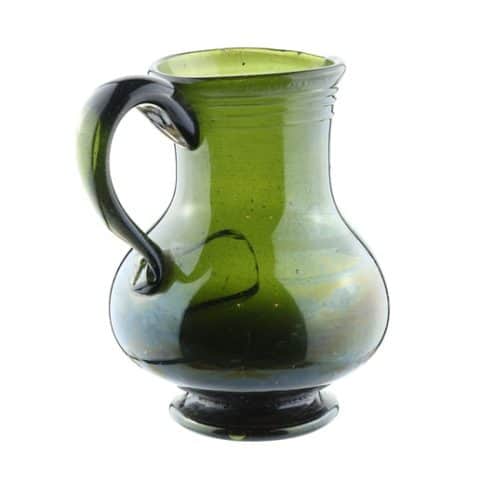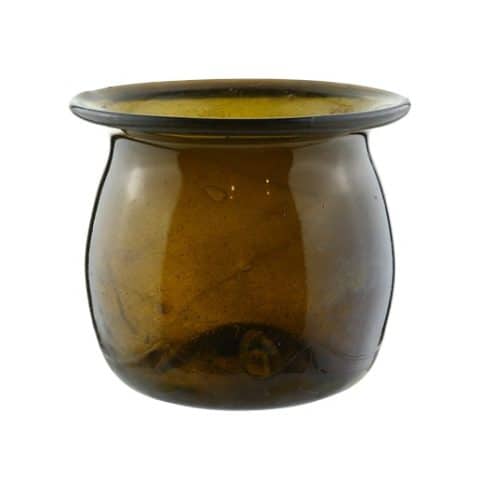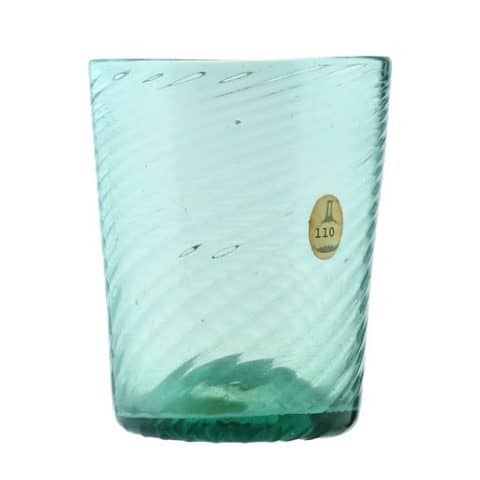Zanesville Free-Blown Bowl
Zanesville Free-blown Bowl
G. W. Kearns & Co., Zanesville, Ohio
Yellow with Olive Tone Cylindrical Bowl
Provenance: John Fifer Collection, ex Darl Fifer Collection

This wonderful bright yellow with olive tone free-blown bowl is attributed to G. W. Kearns & Co. in Zanesville, Ohio from 1860 to 1868. George Washington Kearns and his associates were involved in a number of glass factories and operating companies, almost all located at Zanesville.
The free-blown bowl is cylindrical in form with a pontil scar. The diameter is 8-¾”, with the bottom 5” in diameter. The bowl is 2-¼” tall and has a tooled outward folded rim.

George W. Kearns was born around 1821 in Pennsylvania. He moved to Muskingum County, Zanesville, Ohio in 1842 from Pittsburgh and initially was a tailor. He married Elizabeth J. Stokes in 1847 and they would have eight children, George J., William H., Ella, Lindon, Edward, Lizzie, Anna, and Mary Kearns.
Kearns would next partner in business with five experienced glass workers named Joseph Burns, W. F. Spence, Thomas Reynolds, George Wendt, and Samuel Turner. They each invested $500 apiece and purchased the operating rights to the old White Glass Works, a tableware factory that had been established as the Zanesville Glass Mfg. Co. by several local businessmen in 1815. The glassworks was located on the southwest corner of 3rd and Market Street in Zanesville, which in the early nineteenth century was a small town that incorporated one year earlier in 1814. The town was surrounded by thick forests and had all the necessary ingredients for making glass such as sand, potash, and lime which could be obtained nearby. They also had access to coal and wood to fuel the glass furnaces. Making glasswares helped ensure meeting the demands of an increase in population as well as an expanding economic base.
See the museum example of an aqua 19-rib Zanesville Pattern Molded Bowl attributed to White Glass Works.
The glassworks fired up their ovens sometime in mid-1844 under the banner Burns, Reynolds & Company. In late 1844, two of the original partners sold their interests, followed by another pair doing the same two years later. The final two original partners, Joseph Burns and George W. Kearns went by Burns & Kearns Co. in some records but no record can confirm this as their official name. They would sell the business in 1848 to Arnold Lippitt, a local businessman who owned the Slago Glass Works, another local glass factory that produced tableware. Lippitt called the factory the Zanesville Glass Works, although that name may have been used earlier. He operated the firm until about 1851. There is no record of any Burns & Kearns marked glass pieces known to researchers and collectors during this era.
George W. Kearns and Joseph Burns began construction of a bottle glass factory at Putnam, Ohio across the Muskingum River from Zanesville in 1849. Putnam was one of the oldest settlements in Ohio and was established around 1800. The first indication that the plant was in operation is from a Zanesville Courier advertisement in April 1851 that reads, “Burns, Kearnes (sic) & Co.” announced, under the heading “Putnam Glass Works” that they had “just completed their extensive Glass Works, and are now manufacturing all sizes of Bottles, Jars, Vials, and other Ware” with their showroom on Main Street in Zanesville. The same Zanesville Courier advertisement was published for more than one year. In the fall of 1852, the works were reported to be “in full operation” and their showroom on Main Street was advertised in the local paper until May 1853. The glassworks failed shortly thereafter, and the courts assigned Alfred Merrick as trustee for liquidation, although those duties quickly passed to A. A. Guthrie on June 10, 1853.
George W. Kearns and Joseph Burns recovered from their losses with Putnam Glass Works and while operating as G. W. Kearns & Co., purchased the former Cassel & Galigher factory – their employer for the intervening years. On April 27, 1860, they added George’s younger brother, Noah Kearns, as a partner. George Thomas Kearns Jr. would also join the group as a glassblower. The glassworks was a green glass plant that made a variety of bottles and vials, dinnerware as well as fruit jars. This would have been the period our free-blown bowl was made.
Joseph Burns died on November 16, 1864, and the remaining group continued to operate a window-glass factory at the corner of Main and First streets. The factory became Kearns, Herdman & Gorsuch in 1869 and continued to make bottles and window glass until the United Glass Co. bought the window glass plant in 1891. George W. Kearns would work in the glass factory until his death in 1906.
Primary Image: Yellow Zanesville Free-Blown Bowl imaged on location by the FOHBC Virtual Museum midwest studio led by Alan DeMaison.
Support: Reference to Zanesville Glass: A History of the Companies Which Have Manufactured and the People Who Have Contributed to Its Artistry, Elegance and Endurance for Nearly Two Hundred Years, Paperback, Unabridged, January 1, 2011 by J. William Barrett II
Support: Reference to The Kearns Glass Companies of Zanesville by Bill Lockhart, Pete Schulz, Beau Schriever, Bill Lindsey, and Carol Serr with contributions by Bill Barrett and David Whitten
Support: Reference to The Robinsons of Zanesville 1893-1900 by Marg Iwen, Bottles and Extras, 2004
Support: Reference to Ohio Glass 1815-1953, The Toledo Museum of Art, October 1953
Support: Reference to American Bottles and Flasks and Their Ancestry by Helen McKearin and Kenneth M. Wilson, Crown Publishers Inc., New York, 1978.
Support: Reference to Zanesville, Ohio and the Glass Industry: An Enduring Romance, Privately printed, Zanesville, Ohio., 1997, J. William Barrett II.
Support: Reference to Zanesville, Ohio, and the Evolution of its Glass Industry, Bottles and Extras, July 1998, J. William Barrett II.
Support: Reference to Zanesville Glass: A History of the Companies Which Have Manufactured and the People Who Have Contributed to its Artistry, Elegance and Endurance for Nearly Two Hundred Years, Privately printed, Zanesville, 2011, J. William Barrett II.
Support Images: Auction Lot 23: Freeblown Compote, probably a Zanesville glasshouse, Zanesville, Ohio, 1830-1850. Shallow cylindrical bowl with tooled knopf stem and applied saucer foot, medium yellow amber, tooled rim – pontil scar, ht. 3 5/8 inches, bowl dia. 6 1/8 inches, foot dia. 3 1/4 inches; (approximately half the rim has been finely buffed). Similar in form and construction to McK plate 28, #9 A well-constructed bowl with an appealing and rare form. Generally fine condition. – Norman Heckler, Norman C. Heckler & Company
Support Image: Bowl, United States, probably Ohio, Zanesville, 1820-1840, Furnishings; Serviceware, Pattern-molded blown glass, Height: 2 7/8 in. (7.3 cm); Diameter: 10 1/4 in. (26.04 cm), Decorative Arts Council Curatorial Acquisitions Discretionary Fund (M.84.19.2) – Los Angeles County Museum of Art
Support Images: Auction Lot 1: Pattern Molded Handled Jug, ribbed and swirled to the right, 24 ribs, a Zanesville glasshouse, Zanesville, Ohio, 1820-1840. Globular with applied solid handle, medium orange amber with some reddish tones, inward rolled mouth – pontil scar, ht. 6 1/4 inches, greatest dia. 5 inches; (handle rigaree has been broken away, 1/4 inch star fissure at lower body). Similar in form and construction to MW color plate V, #5 A rare, beautiful form in a larger than usual size. – Norman Heckler, Norman C. Heckler & Company, The Peter Tillou Collection, Auction #190
Support Images: Auction Lot 139: Freeblown Footed Bowl, Midwest America, possibly a Zanesville glasshouse, 1820-1840. Cylindrical bowl flaring to rim with drawn cylindrical foot, medium yellow amber, inward folded rim – pontil scar, ht. 2 1/8 inches, bowl dia. 5 3/8 inches, foot dia. 2 3/4 inches; (just a touch of usage wear on rim). Similar in form and construction to McK plate 68, #15 Appealing smaller size and unusual form. Fine condition. – Norman Heckler, Norman C. Heckler & Company, Auction #146
Join the FOHBC: The Virtual Museum is a project of the Federation of Historical Bottle Collectors (FOHBC). To become a member.






























